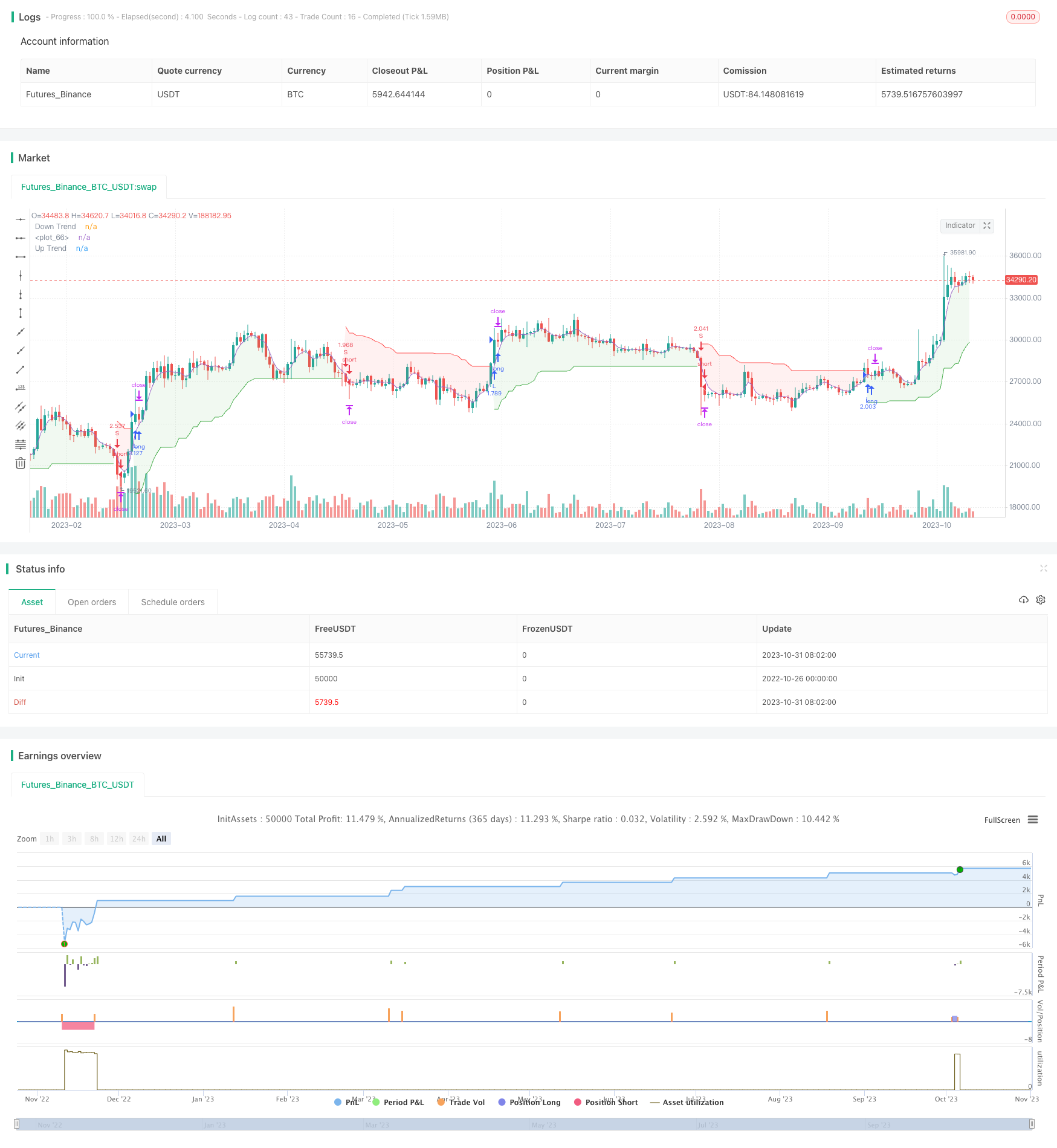
概述
海因阿修与超级趋势策略是一种融合海因阿修蜡烛图和超级趋势指标的趋势跟踪策略。该策略旨在识别趋势方向,在趋势区域进行交易,并在趋势反转时快速退出,最大限度地减少非趋势交易所带来的损失。
策略原理
海因阿修蜡烛图是一种特殊的K线图,它使用开盘价、收盘价、最高价、最低价的平均值来绘制蜡烛实体,从而能够过滤市场噪音,使图形更加清晰。超级趋势指标则由两个曲线组成,通过动态的支撑和阻力线来判断趋势方向。
该策略首先计算海因阿修蜡烛图,然后基于海因阿修K线计算超级趋势指标。当价格突破超级趋势指标时,产生交易信号。具体来说,该策略使用海因阿修K线计算真实波幅,再结合波幅和平均价格得到超级趋势的上下轨。当价格从下轨突破时产生做多信号,从上轨突破时产生做空信号。
策略还对超级趋势指标进行了参数优化,采用最佳参数组合,从而提高指标的灵敏度。此外,策略加入了止损机制,能够在保证利润的同时控制风险。
优势分析
- 使用海因阿修蜡烛图能过滤噪音,使信号更清晰。
- 超级趋势指标能快速捕捉趋势变化,及时发出交易信号。
- 参数优化提高了指标的可靠性。
- 内置止损机制,能够有效控制风险。
- 结合趋势跟踪和机械交易系统,自动化程度高。
风险分析
- 交易系统自动化程度高,需密切监控以避免异常。
- 海因阿修蜡烛图虽能过滤噪音,但也会漏过极小的反转信号。
- 超级趋势指标可能会产生错误信号,导致过早入场或止损。
- 止损点设置不当也会导致不必要的亏损。
- 回测数据不充分可能导致过拟合。实盘与回测结果可能有较大偏差。
优化方向
- 测试更多参数组合,进一步优化超级趋势指标。
- 尝试其他指标确认超级趋势指标信号,降低错误信号率。
- 优化止损策略,在保证利润的前提下尽量减少不必要止损。
- 增加机器学习算法,利用大数据训练判断真实趋势的能力。
- 使用更长的时间周期和更多不同市场的历史数据进行回测,提高可靠性。
总结
海因阿修与超级趋势策略是一种趋势跟踪策略。它能识别趋势方向,大趋势下进行交易,在反转时快速止损。策略集成了海因阿修蜡烛图的噪音过滤以及超级趋势指标的快速捕捉趋势变化的能力。通过参数优化和止损机制的设计,能够在提高收益的同时控制风险。未来可通过进一步优化参数,增加确认指标,扩大回测数据等方法来优化该策略,提升系统稳定性和可靠性。
策略源码
/*backtest
start: 2022-10-26 00:00:00
end: 2023-11-01 00:00:00
period: 1d
basePeriod: 1h
exchanges: [{"eid":"Futures_Binance","currency":"BTC_USDT"}]
*/
//@version=5
strategy("Heiken Ashi & Super Trend_ARM", overlay=true, pyramiding=1,initial_capital = 10000, default_qty_type= strategy.percent_of_equity, default_qty_value = 100, calc_on_order_fills=false, slippage=0,commission_type=strategy.commission.percent,commission_value=0.02)
///////////////////////////////////////////////////
////////////////////Function///////////////////////
///////////////////////////////////////////////////
heikinashi_open = request.security(ticker.heikinashi(syminfo.tickerid), timeframe.period, open)
heikinashi_high = request.security(ticker.heikinashi(syminfo.tickerid), timeframe.period, high)
heikinashi_low = request.security(ticker.heikinashi(syminfo.tickerid), timeframe.period, low)
heikinashi_close= request.security(ticker.heikinashi(syminfo.tickerid), timeframe.period, close)
heikinashi_color = heikinashi_open < heikinashi_close ? #53b987 : #eb4d5c
// plotbar(heikinashi_open, heikinashi_high, heikinashi_low, heikinashi_close, color=heikinashi_color)
x_sma(x, y) =>
sumx = 0.0
for i = 0 to y - 1
sumx := sumx + x[i] / y
sumx
x_rma(src, length) =>
alpha = 1/length
sum = 0.0
sum := na(sum[1]) ? x_sma(src, length) : alpha * src + (1 - alpha) * nz(sum[1])
x_atr(length) =>
trueRange = na(heikinashi_high[1])? heikinashi_high-heikinashi_low : math.max(math.max(heikinashi_high - heikinashi_low, math.abs(heikinashi_high - heikinashi_close[1])), math.abs(heikinashi_low - heikinashi_close[1]))
//true range can be also calculated with ta.tr(true)
x_rma(trueRange, length)
x_supertrend(factor, atrPeriod) =>
src = (heikinashi_high+heikinashi_low)/2
atr = x_atr(atrPeriod)
upperBand = src + factor * atr
lowerBand = src - factor * atr
prevLowerBand = nz(lowerBand[1])
prevUpperBand = nz(upperBand[1])
lowerBand := lowerBand > prevLowerBand or heikinashi_close[1] < prevLowerBand ? lowerBand : prevLowerBand
upperBand := upperBand < prevUpperBand or heikinashi_close[1] > prevUpperBand ? upperBand : prevUpperBand
int direction = na
float superTrend = na
prevSuperTrend = superTrend[1]
if na(atr[1])
direction := 1
else if prevSuperTrend == prevUpperBand
direction := heikinashi_close > upperBand ? -1 : 1
else
direction := heikinashi_close < lowerBand ? 1 : -1
superTrend := direction == -1 ? lowerBand : upperBand
[superTrend, direction]
///////////////////////////////////////////////////
////////////////////Indicators/////////////////////
///////////////////////////////////////////////////
factor = input.float(3.0, "Factor", step = 0.01)
atrPeriod = input(10, "ATR Length")
[supertrend, direction] = x_supertrend(factor, atrPeriod)
bodyMiddle = plot((heikinashi_open + heikinashi_close) / 2, display=display.none)
upTrend = plot(direction < 0 ? supertrend : na, "Up Trend", color = color.green, style=plot.style_linebr)
downTrend = plot(direction < 0? na : supertrend, "Down Trend", color = color.red, style=plot.style_linebr)
fill(bodyMiddle, upTrend, color.new(color.green, 90), fillgaps=false)
fill(bodyMiddle, downTrend, color.new(color.red, 90), fillgaps=false)
///////////////////////////////////////////////////
////////////////////Strategy///////////////////////
///////////////////////////////////////////////////
var bool longCond = na, var bool shortCond = na, longCond := nz(longCond[1]), shortCond := nz(shortCond[1])
var int CondIni_long = 0, var int CondIni_short = 0, CondIni_long := nz(CondIni_long[1]), CondIni_short := nz(CondIni_short[1])
var float open_longCondition = na, var float open_shortCondition = na
long = ta.change(direction) < 0
short = ta.change(direction) > 0
longCond := long
shortCond := short
CondIni_long := longCond[1] ? 1 : shortCond[1] ? -1 : nz(CondIni_long[1])
CondIni_short := longCond[1] ? 1 : shortCond[1] ? -1 : nz(CondIni_short[1])
longCondition = (longCond[1] and nz(CondIni_long[1]) == -1)
shortCondition = (shortCond[1] and nz(CondIni_short[1]) == 1)
open_longCondition := long ? close[1] : nz(open_longCondition[1])
open_shortCondition := short ? close[1] : nz(open_shortCondition[1])
//TP
tp = input.float(1.1 , "TP [%]", step = 0.1)
//BACKTESTING inputs --------------------------------------------------------------------------------------------------------------------------------------------------------------------------------------------------------------------------------------------------------------------------------------------------------
testStartYear = input.int(2000, title="start year", minval = 1997, maxval = 3000, group= "BACKTEST")
testStartMonth = input.int(01, title="start month", minval = 1, maxval = 12, group= "BACKTEST")
testStartDay = input.int(01, title="start day", minval = 1, maxval = 31, group= "BACKTEST")
testPeriodStart = timestamp(testStartYear,testStartMonth,testStartDay,0,0)
testStopYear = input.int(3333, title="stop year", minval=1980, maxval = 3333, group= "BACKTEST")
testStopMonth = input.int(12, title="stop month", minval=1, maxval=12, group= "BACKTEST")
testStopDay = input.int(31, title="stop day", minval=1, maxval=31, group= "BACKTEST")
testPeriodStop = timestamp(testStopYear, testStopMonth, testStopDay, 0, 0)
testPeriod = time >= testPeriodStart and time <= testPeriodStop ? true : false
// Backtest ==================================================================================================================================================================================================================================================================================================================================
if longCond
strategy.entry("L", strategy.long, when=testPeriod)
if shortCond
strategy.entry("S", strategy.short, when=testPeriod)
strategy.exit("TP_L", "L", profit =((open_longCondition * (1+(tp/100))) - open_longCondition)/syminfo.mintick)
strategy.exit("TP_S", "S", profit =((open_shortCondition * (1+(tp/100))) - open_shortCondition)/syminfo.mintick)